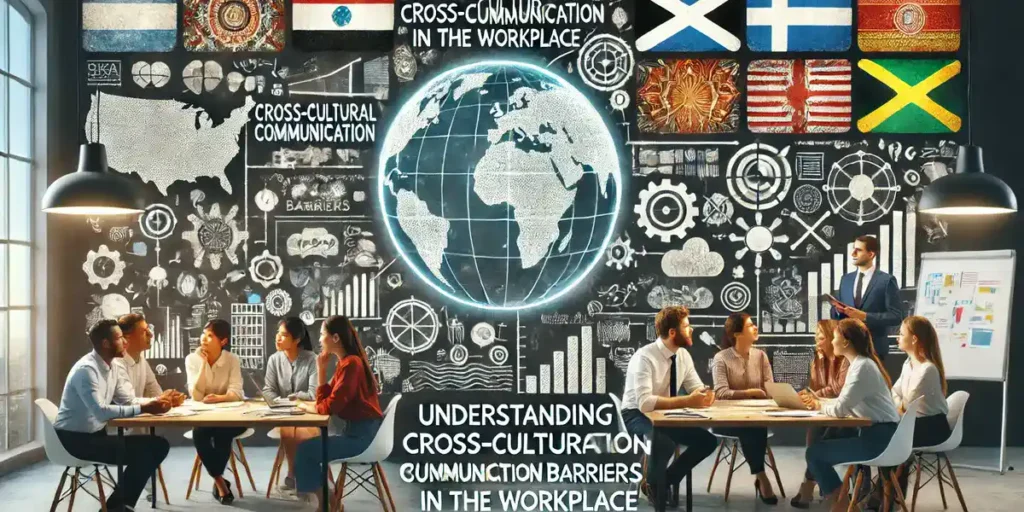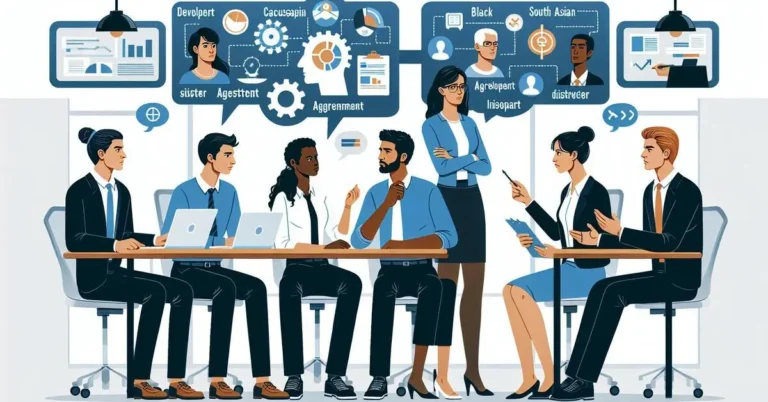Cross Cultural Communication Barriers in Workplace
Navigating a diverse workplace can be both rewarding and challenging. As businesses become more global, cross-cultural communication barriers often emerge, creating misunderstandings and inefficiencies. I’ve seen firsthand how these barriers can hinder collaboration and productivity.
Cross-cultural communication barriers in the workplace often arise from differences in language, non-verbal cues, and cultural norms. These differences can lead to misunderstandings, reduced collaboration, and workplace conflicts.
Understanding Cross Cultural Communication Barriers in the Workplace

Addressing cross-cultural communication barriers is crucial to building an inclusive and productive work environment. Inefficiencies and misunderstandings can arise if these barriers are left unaddressed.
Cross-cultural communication barriers refer to obstacles that impede effective interaction between individuals from different cultural backgrounds. These barriers affect both verbal and non-verbal communication, leading to potential conflicts and reduced collaboration.
Importance: Recognizing cross-cultural communication barriers helps organizations create strategies to overcome them. By addressing these obstacles, companies can improve teamwork, innovation, and employee satisfaction. Employees become more engaged and motivated when they feel understood and respected, regardless of their cultural backgrounds.
Language Differences
Language barriers are perhaps the most obvious. Misunderstandings can occur when employees do not share a common language or have varying levels of proficiency.
- Solution: Encourage language training programs and use clear, simple language in communication. Consider using translation tools for critical communications.

Non-Verbal Misinterpretations
Different cultures interpret non-verbal cues such as gestures, facial expressions, and body language differently. What is considered polite in one culture might be rude in another.
- Solution: Raise awareness about these differences through training and encourage employees to ask for clarification when they are unsure about non-verbal signals.
Cultural Assumptions and Stereotypes
Preconceived notions about certain cultures can lead to misunderstandings and conflict. These assumptions can affect how we perceive others’ behavior and intentions.
- Solution: Foster an open-minded culture where employees are encouraged to learn about and respect different cultural backgrounds. Diversity training can be very effective in this regard.
Different Communication Styles
Some cultures prefer direct communication, while others might find it confrontational and prefer a more indirect approach. These differences can lead to confusion and frustration.
- Solution: Educate employees on various communication styles and encourage them to adapt their approach depending on the context and the people they are interacting with.
Time Zone Differences
For multinational companies, working across different time zones can be a significant barrier to effective communication. It can lead to delays and misunderstandings if not managed properly.
- Solution: Use scheduling tools that show multiple time zones and plan meetings at times that are reasonable for all participants. Encourage asynchronous communication methods like email and project management tools.
Different Norms for Professionalism
Standards for what is considered professional behavior can vary widely. This includes dress codes, meeting etiquette, and even attitudes toward hierarchy and authority.
- Solution: Develop clear, inclusive policies that consider the diverse backgrounds of employees. Provide guidelines but remain flexible to accommodate cultural differences.
Technological Barriers
Access to and familiarity with technology can vary among cultures. This can hinder effective communication, especially in a remote or hybrid work environment.
- Solution: Provide training and support to ensure all employees can use communication tools effectively. Ensure that technology is accessible to everyone.
Impact of Communication Barriers on Workplace Efficiency
Communication barriers in a diverse workplace significantly impact efficiency, affecting team collaboration and employee satisfaction.
Effects on Team Collaboration
Barriers in communication disrupt team collaboration, resulting in misunderstandings or conflicts. Productivity suffers when teammates face difficulty expressing ideas clearly. For instance, language barriers can lead to miscommunication, and non-verbal misinterpretations can escalate tensions. Culturally diverse teams may struggle with different communication styles, slowing decision-making processes. As a result, projects may experience delays, and team members might feel less cohesive.
Effects on Employee Satisfaction
Communication barriers negatively affect employee satisfaction. When employees feel undervalued or misunderstood, job dissatisfaction rises. For example, differing cultural norms can create a sense of exclusion. If employees from different backgrounds cannot convey their thoughts effectively, it can result in frustration and low morale. This impacts their overall engagement and commitment to the organization. In extreme cases, high turnover rates may occur due to unresolved communication issues, causing additional recruitment and training costs.
Addressing cross-cultural communication barriers fosters better team collaboration and enhances overall employee satisfaction, thereby improving workplace efficiency.
How does anxiety impact cross-cultural communication in the workplace?
Anxiety can significantly affect cross-cultural communication in the workplace, creating a range of challenges that can hinder effective interaction and collaboration. Here’s how anxiety impacts this crucial aspect of workplace dynamics and some strategies to mitigate its effects.
1. Fear of Miscommunication
Anxiety often stems from the fear of saying the wrong thing or being misunderstood, especially when language barriers and cultural differences are present. This fear can lead to overthinking and hesitation in communication.
- Impact: Employees may avoid conversations, leading to a lack of information sharing and collaboration.
- Solution: Encourage a supportive environment where making mistakes is seen as a learning opportunity. Provide language support and cultural training to build confidence.
2. Overemphasis on Language Proficiency
Employees may feel anxious about their level of language proficiency, worrying that they will not be able to express themselves clearly or understand others fully.
- Impact: This can lead to reduced participation in meetings, reluctance to speak up, and potential isolation.
- Solution: Promote the use of simple, clear language and provide tools for translation and language learning. Encourage patience and active listening among team members.
3. Non-Verbal Communication Challenges
Cultural differences in non-verbal communication, such as gestures and facial expressions, can cause anxiety. Employees might worry about inadvertently offending someone or misinterpreting non-verbal cues.
- Impact: Misunderstandings and miscommunications can arise, leading to frustration and conflict.
- Solution: Offer training on non-verbal communication norms in different cultures and create an open environment where employees feel comfortable asking for clarification.
4. Uncertainty in Social Norms
Different cultural backgrounds bring different social norms and expectations. Uncertainty about these norms can cause anxiety, particularly in social and professional interactions.
- Impact: Employees may feel uncomfortable in social settings or unsure about how to approach certain situations, leading to awkward interactions and potential exclusion.
- Solution: Foster a culture of inclusivity and respect. Provide guidelines on cultural norms and encourage employees to share their cultural practices.
5. Pressure to Conform
Anxiety can arise from the pressure to conform to the dominant culture in the workplace. This can be particularly stressful for employees from minority cultures.
- Impact: Employees may suppress their cultural identity, leading to decreased job satisfaction and a sense of not belonging.
- Solution: Celebrate cultural diversity and encourage employees to share their cultural backgrounds. Promote an inclusive workplace where diversity is valued and respected.
6. Performance Anxiety
In a multicultural workplace, employees might experience performance anxiety due to the perceived higher stakes of cross-cultural interactions. They may worry about being judged more harshly or not meeting expectations.
- Impact: This can lead to stress, burnout, and decreased productivity.
- Solution: Provide regular feedback and support. Recognize and reward efforts to engage in cross-cultural communication. Offer stress management resources.
Strategies to Overcome Cross Cultural Communication Barriers
Addressing cross-cultural communication barriers in the workplace enhances collaboration and productivity. By implementing targeted strategies, teams can navigate these challenges effectively.
Implementing Effective Training Programs
Effective training programs provide employees with cultural awareness. These programs teach team members about different communication styles, cultural norms, and conflict resolution. For example, companies can offer workshops on active listening and cultural sensitivity. According to the Society for Human Resource Management (SHRM), over 70% of companies report increased employee engagement after cultural competency training. Regular training sessions ensure employees remain informed and adaptable, mitigating miscommunications.
Encouraging Inclusivity and Diversity
Encouraging inclusivity and diversity fosters an open environment where all employees feel valued. Companies should create policies that promote diverse hiring practices and support an inclusive atmosphere. For instance, establishing employee resource groups (ERGs) can provide a platform for underrepresented groups to voice concerns and share experiences. A McKinsey report highlights that diverse teams are 35% more likely to outperform their non-diverse counterparts. Additionally, celebrating cultural events and holidays from various backgrounds allows employees to connect personally and understand each other’s cultures better.
Case Studies of Successful Cross Cultural Communication Strategies
Successful cross-cultural communication strategies can bridge gaps and enhance collaboration. Let’s explore examples from a multinational company and a non-profit organization.
Example from a Multinational Company
One prominent example comes from IBM. IBM implemented a global training program focusing on cultural fluency. The program included language classes, cultural awareness workshops, and virtual collaboration tools. Employees from diverse backgrounds participated in role-playing exercises to understand different communication styles.
IBM emphasized continuous learning, integrating cultural competency into their leadership development programs. Management consistently encouraged open dialogue and feedback, establishing a culture of inclusivity. Performance metrics showed increased employee satisfaction and improved project outcomes, validating the effectiveness of these strategies.
Example from a Non-Profit Organization
Doctors Without Borders (Médecins Sans Frontières) also provides a successful case of cross-cultural communication. This organization operates in over 70 countries, requiring effective communication among teams from various cultural backgrounds.
They developed a comprehensive onboarding process, including intensive cultural training. The training addressed local customs, languages, and conflict resolution techniques. Field workers received continuous support through mentorship programs and access to culturally competent resources.
By prioritizing cultural sensitivity, Doctors Without Borders enhanced their operational efficiency and improved team cohesion. The organization’s ability to deliver critical services in diverse environments underscores the success of its communication strategies.
Conclusion
Understanding and addressing cross-cultural communication barriers is crucial for any global business aiming to thrive. It’s clear that language differences, communication styles, and cultural norms can significantly impact workplace efficiency. Implementing training programs and inclusive policies can make a substantial difference in team collaboration.
Real-world examples like IBM and Doctors Without Borders show that prioritizing cultural fluency and sensitivity leads to tangible benefits. When employees feel understood and respected, their satisfaction and productivity naturally improve. Adopting these strategies can transform a diverse workplace into a cohesive and efficient unit.






